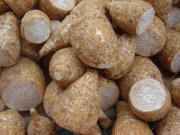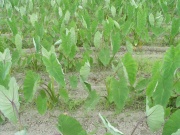Difference between revisions of "Taro flour"
Jump to navigation
Jump to search
m (Text replace - "== Authority ==" to "== Sources Checked for Data in Record ==") |
|||
| (One intermediate revision by one other user not shown) | |||
| Line 1: | Line 1: | ||
| − | [[File:tarocormvt.jpg|thumb|Taro croms | + | [[File:tarocormvt.jpg|thumb|Taro croms ''Colocasia esculenta'']] |
| − | |||
| − | ''Colocasia esculenta'']] | ||
== Description == | == Description == | ||
| − | A white, edible powder made from the crushed root of the ''Colocasia esculenta'' plant that is native to Asia and the Pacific Islands. Taro flour is used to make a starchy paste called poi. The starchy mixture has also been used as an [ | + | A white, edible powder made from the crushed root of the ''Colocasia esculenta'' plant that is native to Asia and the Pacific Islands. Taro flour is used to make a starchy paste called poi. The starchy mixture has also been used as an [[adhesive|adhesive]]. |
| − | + | [[File:tarof5.jpg|thumb|Taro ''Colocasia esculenta'']] | |
== Synonyms and Related Terms == | == Synonyms and Related Terms == | ||
''Colocasia esculenta''; harina de taro (Esp.); cocoyam; dasheen; eddo; juau; poi | ''Colocasia esculenta''; harina de taro (Esp.); cocoyam; dasheen; eddo; juau; poi | ||
| − | + | == Risks == | |
| − | |||
| − | |||
| − | == | ||
Raw taro roots and leaves are poisonous; they must be cooked prior to eating. | Raw taro roots and leaves are poisonous; they must be cooked prior to eating. | ||
| − | == | + | ==Resources and Citations== |
* G.S.Brady, ''Materials Handbook'', McGraw-Hill Book Co., New York, 1971 Comment: p. 633 | * G.S.Brady, ''Materials Handbook'', McGraw-Hill Book Co., New York, 1971 Comment: p. 633 | ||
| Line 25: | Line 20: | ||
* ''The American Heritage Dictionary'' or ''Encarta'', via Microsoft Bookshelf 98, Microsoft Corp., 1998 | * ''The American Heritage Dictionary'' or ''Encarta'', via Microsoft Bookshelf 98, Microsoft Corp., 1998 | ||
| − | * ''Encyclopedia Britannica'', http://www.britannica.com Comment: "taro" | + | * ''Encyclopedia Britannica'', http://www.britannica.com Comment: "taro" E [Accessed 28 Sept. 2005]. |
| − | * Wikipedia | + | * Wikipedia: http://en.wikipedia.org/wiki/Taro (Accessed Sept. 28, 2005) |
[[Category:Materials database]] | [[Category:Materials database]] | ||
Latest revision as of 07:35, 8 June 2022
Description
A white, edible powder made from the crushed root of the Colocasia esculenta plant that is native to Asia and the Pacific Islands. Taro flour is used to make a starchy paste called poi. The starchy mixture has also been used as an Adhesive.
Synonyms and Related Terms
Colocasia esculenta; harina de taro (Esp.); cocoyam; dasheen; eddo; juau; poi
Risks
Raw taro roots and leaves are poisonous; they must be cooked prior to eating.
Resources and Citations
- G.S.Brady, Materials Handbook, McGraw-Hill Book Co., New York, 1971 Comment: p. 633
- Random House, Webster's Encyclopedic Unabridged Dictionary of the English Language, Grammercy Book, New York, 1997
- The American Heritage Dictionary or Encarta, via Microsoft Bookshelf 98, Microsoft Corp., 1998
- Encyclopedia Britannica, http://www.britannica.com Comment: "taro" E [Accessed 28 Sept. 2005].
- Wikipedia: http://en.wikipedia.org/wiki/Taro (Accessed Sept. 28, 2005)

